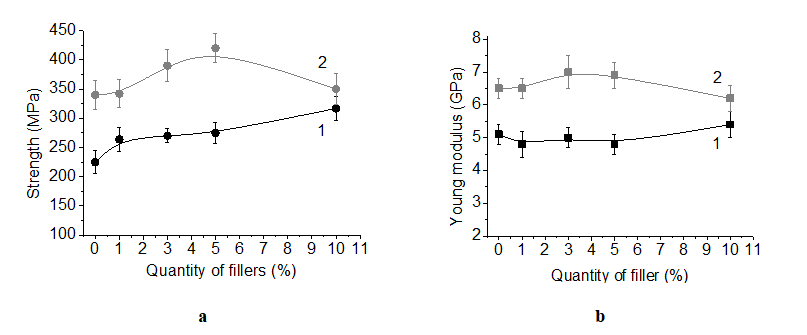Journal of
eISSN: 2574-9943


Short Communication Volume 3 Issue 5
1Peter the Great Polytechnic St. Petersburg University, Russia
2St. Petersburg State University of Industrial Technologies and Design, Russia
3Institute of Macromolecular Compounds, Russian Academy of Sciences, Russia
4Applied Cosmetic Dermatology, II University of Naples, Italy
Correspondence: VE Yudin, Peter the Great Polytechnic St. Petersburg University, Russia
Received: August 06, 2019 | Published: September 4, 2019
Citation: Malafeev KV, Moskalyuk OA, Yudin VE, et al. Influence of modified chitin nanofibrils on mechanical properties of polylactide-based fibers. J Dermat Cosmetol . 2019;3(5):125-126 DOI: 10.15406/jdc.2019.03.00127
Authors were shown earlier1 the modification of chitin nanofibrils (CN) surface by PEG seems more promising to receive high quality composite PLA/CN and to ensure uniform dispersion of nanoscale filler in the polymer matrix. This work is a continuation of research in the chosen subject. This article, we will consider the process of obtaining composite fibers from PLA with the addition of CN modified by PEG to evaluate their influence on the structure and mechanical properties of such type composites.
Keywords: polylactide, chitin nanofibrils, polyethylene glycol, melt technology, composites, fiber, mechanical properties
Matrix: Semi-crystalline Poly Lactic Acid (PLA), Nature Works™ 2003D, was supplied by Nature Works, USA. The density is 1.25g/cm3.
Nanofillers: Chitin nanofibrils modified with PEG (CN-PEG) were done at a 2% water suspension of CN (pH 1.9) neutralized at pH 7 by a 10% water solution of NaOH, is slowly added a 2% water solution of PEG at room temperature by a slowly mixing. Soon after the suspension is spray dried to obtain a light brown powder consisting of the spherical particles with diameter in the range from 10μm to 67nm.
Oven-dried PLA and chitin nanoparticles were mixed on a 5mL double-screw microextruder (DSM Xplore, Netherlands) at the screw rate of 50min-1 and temperature 220°C. At the exit of a spinneret after mixing, the melt was cooled with a jet of compressed air. As received fiberswas subjected to orientation drawing by four and six times (λ=4,6) at the temperature 70±5°C with the use of special equipment. The resulting PLA-based composites in the form of high oriented fibers were obtained.
The mechanical properties of PLA fibers prepared by melt spinning were studied with using Instron 5943 tensile test machine. The sample base length was 100mm and the extension rate was 50mm/min. From stress-strain diagrams of the samples, their strength σb, Young modulus Е0 and elongation at break εb were determined.
The dependents of strength and Young modulus of oriented PLA-based composites fibers on the concentration of CN modified PEG are presented at the Figure 1(see below).

Figure 1 Dependents of strength (a) and Young modulus. (b) of PLA-based composites fibers on the concentration of CN modified PEG: 1 - orientational draw in 4 times (λ=4), 2 -orientational draw in 6 times (λ=6).
With the introduction of chitin nanoparticles, modified PEG, for composite fibers with orientational draw in 4 times (λ=4), there is a gradual increase in strength with an increase in the filler content and at a maximum concentration of CN-PEG reaches 320MPa, which is 40% higher than that of the original PLA (Figure 1a). When the orientational drawin 6 times (λ=6) composite fibers of PLA/CN-PEG is observed the maximum strength when the filler concentration is 5wt% and is at the level of σb=420MPa, which is 30% higher than the original PLA matrix. With an increase in the concentration of CN-PEG, the strength of composite fibers is reduced to the initial level.The effect of increasing the strength of composite fibers with small additives of the filler can be explained by the positive effect of СN-PEG on the orientation processes in high-temperature draw of samples and the formation of a more perfect structure of the polymer matrix.2 The decrease in the strength of composite fibers at high filling with chitin particles is explained by the difficulty of the transition of polymer macromolecules to the oriented state and, as a consequence, the accumulation of defects in the polymer matrix.
The Young modulus of composite fibers is independent of the filler concentration and remains at the level of values for the pure PLA. E0 is 5GPa and 6.5GPa for drawing in 4 and 6 times respectively. Elongation at break of the samples are at the level of εb=50% and εb=16% for drawing in 4 and 6 times respectively, it is independent of the filler concentration too.
Thus, it can be seen that with an increase in the degree of orientational draw, the concentrations of fillers, at which an increase in the strength of the fibers is observed, are shifted towards smaller values. Such high oriented fibers may be promising for the development of surgical suture materials or packaging materials with enhanced mechanical properties
The study was performed with the financial support of grant of Russian Science Foundation (project No. 19-73-30003).
The authors report no conflicts of interest.

©2019 Malafeev, et al. This is an open access article distributed under the terms of the, which permits unrestricted use, distribution, and build upon your work non-commercially.